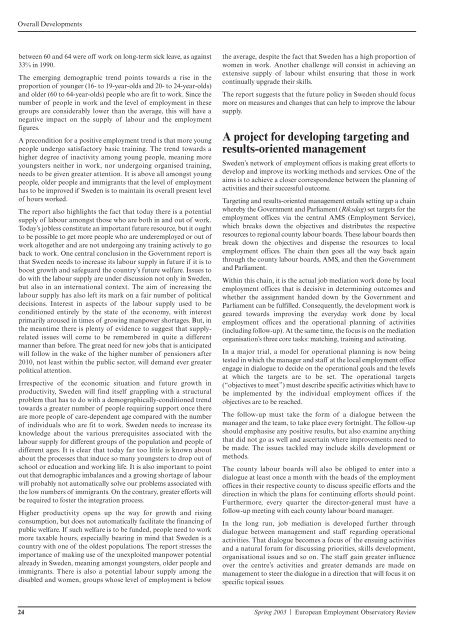FRANCE The
FRANCE The
FRANCE The
You also want an ePaper? Increase the reach of your titles
YUMPU automatically turns print PDFs into web optimized ePapers that Google loves.
Overall Developments<br />
between 60 and 64 were off work on long-term sick leave, as against<br />
33% in 1990.<br />
<strong>The</strong> emerging demographic trend points towards a rise in the<br />
proportion of younger (16- to 19-year-olds and 20- to 24-year-olds)<br />
and older (60 to 64-year-olds) people who are fit to work. Since the<br />
number of people in work and the level of employment in these<br />
groups are considerably lower than the average, this will have a<br />
negative impact on the supply of labour and the employment<br />
figures.<br />
A precondition for a positive employment trend is that more young<br />
people undergo satisfactory basic training. <strong>The</strong> trend towards a<br />
higher degree of inactivity among young people, meaning more<br />
youngsters neither in work, nor undergoing organised training,<br />
needs to be given greater attention. It is above all amongst young<br />
people, older people and immigrants that the level of employment<br />
has to be improved if Sweden is to maintain its overall present level<br />
of hours worked.<br />
<strong>The</strong> report also highlights the fact that today there is a potential<br />
supply of labour amongst those who are both in and out of work.<br />
Today’s jobless constitute an important future resource, but it ought<br />
to be possible to get more people who are underemployed or out of<br />
work altogether and are not undergoing any training actively to go<br />
back to work. One central conclusion in the Government report is<br />
that Sweden needs to increase its labour supply in future if it is to<br />
boost growth and safeguard the country’s future welfare. Issues to<br />
do with the labour supply are under discussion not only in Sweden,<br />
but also in an international context. <strong>The</strong> aim of increasing the<br />
labour supply has also left its mark on a fair number of political<br />
decisions. Interest in aspects of the labour supply used to be<br />
conditioned entirely by the state of the economy, with interest<br />
primarily aroused in times of growing manpower shortages. But, in<br />
the meantime there is plenty of evidence to suggest that supplyrelated<br />
issues will come to be remembered in quite a different<br />
manner than before. <strong>The</strong> great need for new jobs that is anticipated<br />
will follow in the wake of the higher number of pensioners after<br />
2010, not least within the public sector, will demand ever greater<br />
political attention.<br />
Irrespective of the economic situation and future growth in<br />
productivity, Sweden will find itself grappling with a structural<br />
problem that has to do with a demographically-conditioned trend<br />
towards a greater number of people requiring support once there<br />
are more people of care-dependent age compared with the number<br />
of individuals who are fit to work. Sweden needs to increase its<br />
knowledge about the various prerequisites associated with the<br />
labour supply for different groups of the population and people of<br />
different ages. It is clear that today far too little is known about<br />
about the processes that induce so many youngsters to drop out of<br />
school or education and working life. It is also important to point<br />
out that demographic imbalances and a growing shortage of labour<br />
will probably not automatically solve our problems associated with<br />
the low numbers of immigrants. On the contrary, greater efforts will<br />
be required to foster the integration process.<br />
Higher productivity opens up the way for growth and rising<br />
consumption, but does not automatically facilitate the financing of<br />
public welfare. If such welfare is to be funded, people need to work<br />
more taxable hours, especially bearing in mind that Sweden is a<br />
country with one of the oldest populations. <strong>The</strong> report stresses the<br />
importance of making use of the unexploited manpower potential<br />
already in Sweden, meaning amongst youngsters, older people and<br />
immigrants. <strong>The</strong>re is also a potential labour supply among the<br />
disabled and women, groups whose level of employment is below<br />
the average, despite the fact that Sweden has a high proportion of<br />
women in work. Another challenge will consist in achieving an<br />
extensive supply of labour whilst ensuring that those in work<br />
continually upgrade their skills.<br />
<strong>The</strong> report suggests that the future policy in Sweden should focus<br />
more on measures and changes that can help to improve the labour<br />
supply.<br />
A project for developing targeting and<br />
results-oriented management<br />
Sweden’s network of employment offices is making great efforts to<br />
develop and improve its working methods and services. One of the<br />
aims is to achieve a closer correspondence between the planning of<br />
activities and their successful outcome.<br />
Targeting and results-oriented management entails setting up a chain<br />
whereby the Government and Parliament (Riksdag) set targets for the<br />
employment offices via the central AMS (Employment Service),<br />
which breaks down the objectives and distributes the respective<br />
resources to regional county labour boards. <strong>The</strong>se labour boards then<br />
break down the objectives and dispense the resources to local<br />
employment offices. <strong>The</strong> chain then goes all the way back again<br />
through the county labour boards, AMS, and then the Government<br />
and Parliament.<br />
Within this chain, it is the actual job mediation work done by local<br />
employment offices that is decisive in determining outcomes and<br />
whether the assignment handed down by the Government and<br />
Parliament can be fulfilled. Consequently, the development work is<br />
geared towards improving the everyday work done by local<br />
employment offices and the operational planning of activities<br />
(including follow-up). At the same time, the focus is on the mediation<br />
organisation’s three core tasks: matching, training and activating.<br />
In a major trial, a model for operational planning is now being<br />
tested in which the manager and staff at the local employment office<br />
engage in dialogue to decide on the operational goals and the levels<br />
at which the targets are to be set. <strong>The</strong> operational targets<br />
(“objectives to meet”) must describe specific activities which have to<br />
be implemented by the individual employment offices if the<br />
objectives are to be reached.<br />
<strong>The</strong> follow-up must take the form of a dialogue between the<br />
manager and the team, to take place every fortnight. <strong>The</strong> follow-up<br />
should emphasise any positive results, but also examine anything<br />
that did not go as well and ascertain where improvements need to<br />
be made. <strong>The</strong> issues tackled may include skills development or<br />
methods.<br />
<strong>The</strong> county labour boards will also be obliged to enter into a<br />
dialogue at least once a month with the heads of the employment<br />
offices in their respective county to discuss specific efforts and the<br />
direction in which the plans for continuing efforts should point.<br />
Furthermore, every quarter the director-general must have a<br />
follow-up meeting with each county labour board manager.<br />
In the long run, job mediation is developed further through<br />
dialogue between management and staff regarding operational<br />
activities. That dialogue becomes a focus of the ensuing activities<br />
and a natural forum for discussing priorities, skills development,<br />
organisational issues and so on. <strong>The</strong> staff gain greater influence<br />
over the centre’s activities and greater demands are made on<br />
management to steer the dialogue in a direction that will focus it on<br />
specific topical issues.<br />
24 Spring 2003 | European Employment Observatory Review

















